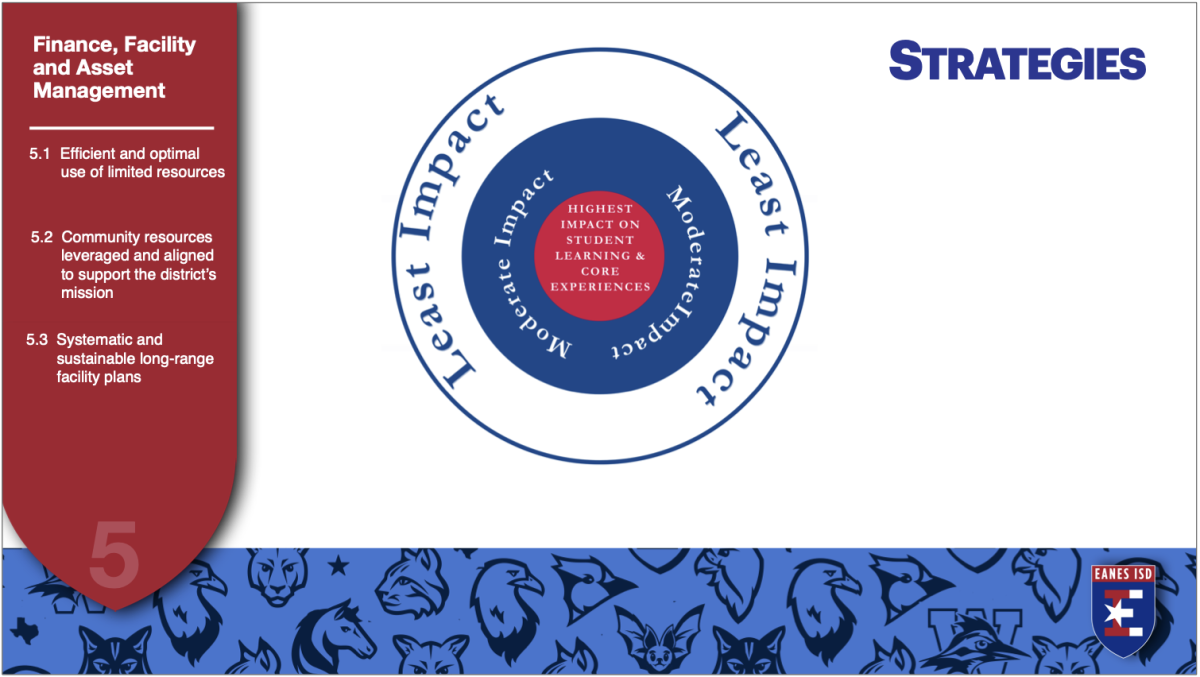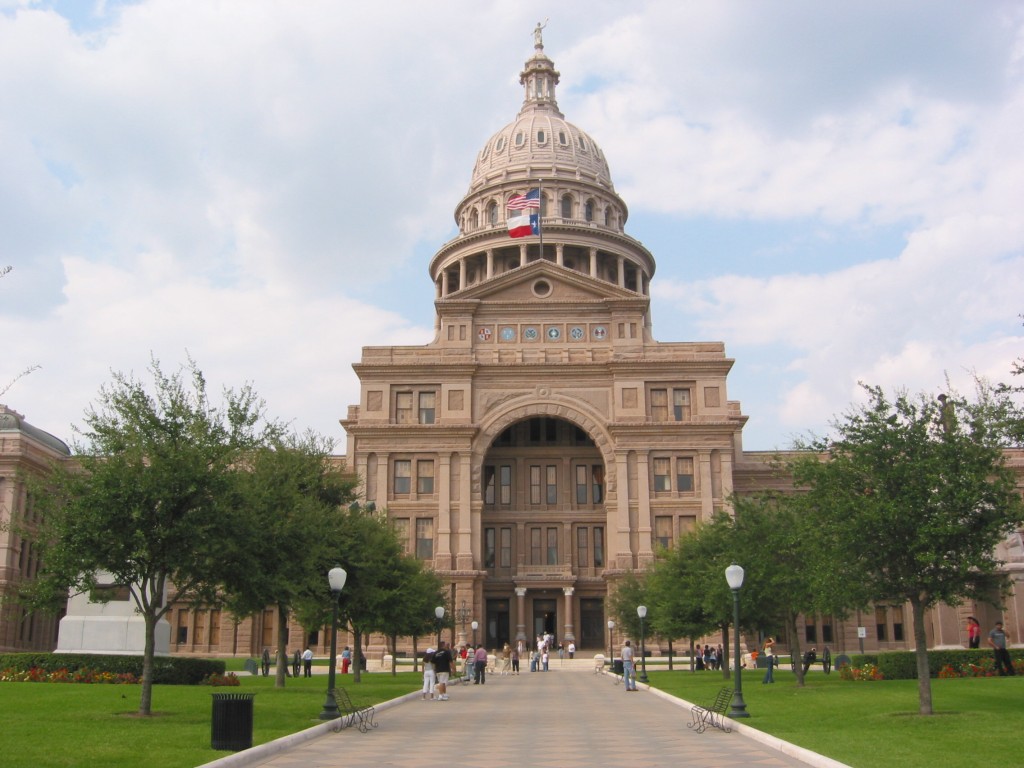Discussion of potential actions to find $5.5-6 million to balance the 2026-27 school year began at the Oct. 21 Eanes ISD Board of Trustees meeting. The deficit was first presented at the Sept. 23 meeting as a “very early” budget projection for the 2026-27 school year, with Chief Financial Officer Chris Scott emphasizing that the projection may change throughout the year, but administration and the school board would like to begin planning for 2026-27 earlier.
Last year, the school board and administration had to address a projected $6.3 million deficit for 2025-26 that increased to $9.6 million for 2026-27 and $11 million for 2027-28. As of the Sept. 23 budget update, the anticipated deficit for 2025-26 has decreased to $2,664,656 after the school board voted to close Valley View Elementary and discontinue the Spanish Immersion program and administration removed the Professional Learning Communities in secondary schools last year. Additionally, the budget deficit further decreased over summer as enrollment for the 2025-26 school year was higher than projected and the Texas Legislature passed HB2.
However, due to primarily stagnant state funding and a projected enrollment decline of 150 students, Eanes ISD expects a decline in funding and investment revenues, causing a decrease in revenue while expenditures increase due to annual salary increases.
As the board of trustees looks at potential options to decrease the projected deficit and rebuild the fund balance, their strategy surrounds avoiding options that would highly impact students. In the Board Strategic Priority: Finance, Facility & Asset Management report, five available options were presented by Scott: Voter Approved Tax Ratification Election (VATRE), increasing revenue, staffing optimization, the elimination and reduction of programs and a salary freeze.
VATRE
VATRE – or copper pennies – was a potential solution presented to the school board to address last year’s budget crisis that was rejected by the school board.
VATRE would involve a community election to approve or reject an increase in property tax rate up to 9 cents in November 2026. The adoption of the 9 available copper pennies has the potential to generate $20 million in tax revenue. The tax revenue would be subjected to recapture and Eanes would receive approximately $3.8 million of the $20 million. While the increased property taxes due to the adoption of additional copper pennies would not be permanent, board member James Spradley believes it would be difficult for a board to reduce the tax rate.
“If you allowed this board $3.8 million, I would say ‘Let’s put it on people right now,’” Spradley said. “We have very deserving staff whose pay increases have not kept up with inflation, and I would gladly do that if I had extra funding.”
While the board was largely against VATRE last year due to the ratio of money that would go to the district versus the state in recapture, the perspective of some board members has changed this year.
“I’m not a fan of copper pennies,” vice president board member Laura Clark said. “It’s bad business to be bringing in $20 million from our community and keep less than $4 million. This is the first time that you got a head tilt from me like ‘Oh, this is interesting,’ and that is it is the only thing on this list that sits in that outside white circle. It is the only thing that we are talking about tonight that does not impact our kids.”
Increase Revenue
According to Scott, there are “not a lot of ways we can increase revenue,” but the board and administration will continue to consider the few potential ways to generating more revenue rather than only options that will reduce expenditures.
One potential way to increase revenue would be through increasing the rental rates of facilities. Scott reported that rental rates increased 25% last year with no drop in demand for facilities. He said they will likely increase again this year, but cautioned against raising rates too quickly.
“We want to be aware of how much we ask of our parents,” Scott said. “We’re charging to use our fields, but that ultimately gets paid by our families to participate in those sports and those activities… We ask a lot of them and I’d like to ask less of them if we could.”
Another proposed opportunity to increase revenue would be the creation of online courses. Online courses would offer students the opportunity to earn high school credit much like similar programs offered by Texas Tech K-12 and University of Texas High School.
The final proposed revenue generating solution is to add more transfer students to elementary schools, particularly at Barton Creek Elementary, the elementary school where transfer family interest is highest.
This year, families from Valley View Elementary blended with Barton Creek Elementary. One concern last year was for the amount of space in the elementary school and the school board and administration assured there would be enough space and indicated a pause on transfer students to do so. However, Scott reported that they anticipate the declining enrollment rates and large graduating fifth grade class will open enough room to add additional transfer students to the elementary school.
Scott estimates there could be a revenue increase up to $600K.
Staffing Optimization
Scott projected savings of around $3.3 million by optimizing staff, or having “fewer people doing the same amount of work.” Staff optimization would take place primarily at the secondary level and would mean increasing class sizes. The elementary schools are already efficient and at the 22:1 student-teacher ratio the district aims to maintain in kindergarten and first grade classes.
Savings from staffing optimization would work via attrition, thus the full amount of savings would not be realized immediately.
Eliminating or Reducing Programs
With the presentation of potential courses of action, Scott did not include the specific programs that would be considered for elimination or reduction, nor was there an estimate for savings.
“If we had any programs that didn’t have advocates and didn’t have people that loved them, we wouldn’t have those programs,” Scott said. “Every one of our programs have advocates both in the school and in the district and our parents who love that program, who have benefited from it and who believe that it’s added value to their kids’ education, so we want to be really careful when we look at these programs.”
However, he did indicate the programs that would be considered would be the smaller programs that have become more expensive to support as time has progressed while the funding for them has not kept up.
Unlike the Spanish Immersion program, there are not programs that would provide a large increase in savings, thus Scott indicated should programs be cut, multiple likely would be.
Salary Freeze
What Scott described as a “last ditch effort,” a salary freeze would temporarily reduce district expenditures by pausing some or all salary increases for one budget cycle. This would provide an estimated saving of $1.6 million, the amount budgeted for a 2% salary increase.
By pursuing the VATRE, increasing revenue and staffing optimization, Scott predicts an estimated $7 million or more in savings.
The board will hold special meetings and community meetings throughout the next few months to focus specifically on the 2026-27 budget and receive feedback from the community before the course of action is finalized in January to allow administration and staff to adjust as needed for the next school year.
“I’d just encourage that we dig deep as we move forward,” McMath said. “We get that community involvement, and we get some feedback so that we can make the right decisions and we can do what is best for our students and our staff.”







